Silves, Sagres, Santiago do Cacém, Sines, Lisbon
World Trip Two
Monday, July 6 2009: Seville - Silves, Portugal
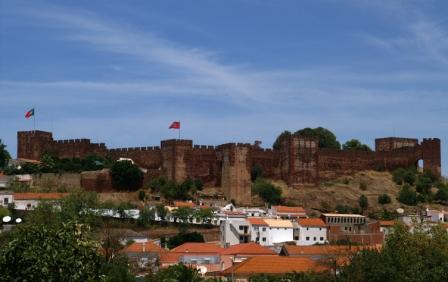 Silves in Portugal.
Silves in Portugal.
Three hours of driving and we were in Silves, Portugal. We left the searing heat of
Seville behind us for the more temperate climes of Portugal. We figured the breeze from the Atlantic Ocean was doing the trick. The only
interesting event on our drive was at the Spanish border.
We were stopped by Spanish troops armed with shotguns and automatic weapons! They were randomly stopping people leaving Spain and checking their
cars for reasons I am not sure of. We were one of the lucky ones who were waved through the checkpoint unhindered.
The medieval architecture of Silves, its stone walls, and the castle are still intact. In fact, the castle has been somewhat restored. The area gains its income
from the cork industry, which is where the restoration funds came from, I assume. There is an archaeological museum in town which indicates people have gone to
great lengths to do things right here. Julia and I were quite weary from the
travel and heat of the day, so we took full advantage of the siesta tradition
that day.
Silves Video
Tuesday, July 7 2009: Silves - Sagres - Santiago do Cacém, Portugal
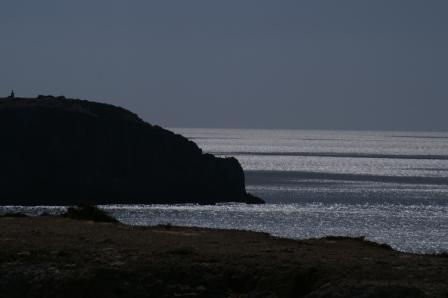 Cliffs at the southernmost point of Portugal.
Cliffs at the southernmost point of Portugal.
Spain and Portugal have made significant efforts with renewable energy. Spain
is third only to the USA and Germany in the production of wind-generated power
globally.
Both in Spain and Portugal, we have driven past vast farms of wind power
generators dotting hillsides like forests of white-metal trees. It seems like
people really care about global warming here, or perhaps they just have a lot
of wind.
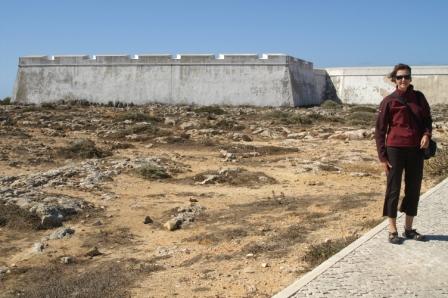 Julia feeling the full force of the wind in Sagres.
Julia feeling the full force of the wind in Sagres.
We visited the Fortress at Sagres on our way from Silves to Santiago do Cacém.
Sagres is located at the southernmost point on mainland Portugal. The
fort is just a tourist attraction now, but at one time it was bristling with
cannons.
The Portuguese used it to defend against the likes of Sir Francis Drake, who
lobbed a few cannonballs at the place in his time. The area reminds me
of Point Reyes in San Francisco. It shares rugged vertical cliffs, brown dry
windswept fields, and vast vistas of a deep blue ocean. The ocean here is the
Atlantic, while at Point Reyes it is the Pacific, but the similarities are
surprising.
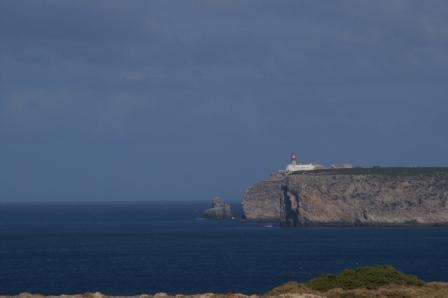 A Point Reyes look-alike.
A Point Reyes look-alike.
I was pleased to see that eucalyptus trees have migrated from Australia and are
now well established throughout Portugal. They
make up the forests along with pines and cork trees. The shiny silvery greens
of the Portuguese forests are well contrasted against the little whitewashed
houses with their terracotta orangey-brown roofs.
In fact, the colors of the buildings are so consistent that I assume it must be
mandated by law. The only exception to the ubiquitous color scheme is the
occasional blue trim. The four-hour drive to Santiago do Cacém along the
southwest coast was very pleasant indeed.
Sagres Video
Wednesday, July 8 2009: Santiago do Cacém and Sines, Portugal
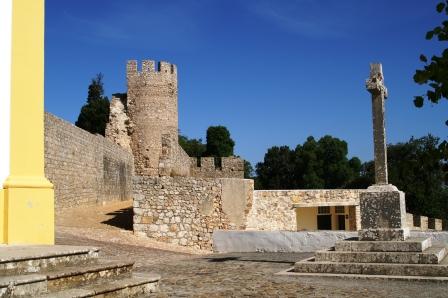 The castle at Santiago do Cacém.
The castle at Santiago do Cacém.
This morning we visited the little church on top of the hill and the castle next
to it at Santiago do Cacém. Julia
and I really like this town. It's not big, in fact, it's small. It's not filled
with tourists, just mostly locals.
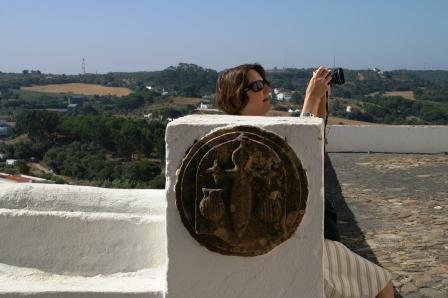 Julia behind the secret symbol of the Knights Templar, who ran the castle for a
time.
Julia behind the secret symbol of the Knights Templar, who ran the castle for a
time.
The town is friendly and set in a beautiful environment. It is hard for me
to put my finger on it, but I really like Santiago do Cacém and Portugal. The
Portuguese seem more organized than the Spanish, and the old folks are a lot
shorter. The town was first inhabited by the Celts, which was a surprise to me
as I thought they were restricted to England. After the Celts came the Romans,
then the Moors, and finally the people we know as the Portuguese. So the castle has
a long history starting with the Moors. It
now has an interesting purpose, functioning as a graveyard. It holds
all the dead of the town in vaults and mausoleums. The castle is well restored, I assume, from
the money from all those funerals.
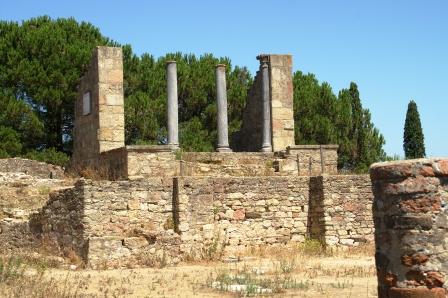 The center of the Roman town of Miróbriga.
The center of the Roman town of Miróbriga.
Just outside of town are the ruins of a 2,000-year-old Roman town, Miróbriga.
This was a surprise, as when you first arrive at the site, it does not look
like there is much there to see. But after we handed over our six Euros and
began to wander around the fields, an ancient city was revealed. We
walked past the remains of humble and more lavish homes. Then the Roman Baths,
with their many bathing rooms and extensive plumbing, became clear to us.
Next, we walked up to the town square, where we could easily imagine the Roman
Governor giving speeches to his minions from the temple steps. After this, we drove to
the small port town of Sines for lunch. Even with its deep water port and oil
refineries, Sines offered us cool breezes and really fresh fish. Not the most
picturesque spot, but still very charming in an industrial kind of way.
Thursday, July 9 2009: Santiago do Cacém - Lisbon, Portugal
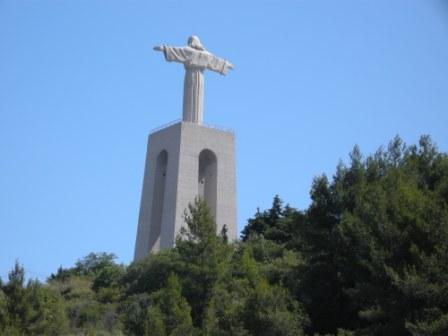 A Rio look-alike.
A Rio look-alike.
Well, it had to happen; all good things come to an end. Today
is our last day of touring in Portugal. Most of the day was spent driving from
Santiago do Cacém to Lisbon.
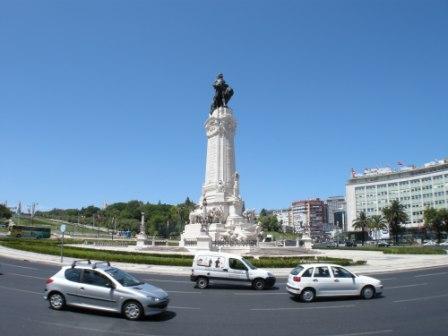 The weather was nice in Lisbon.
The weather was nice in Lisbon.
It turns out that Portugal has a big initiative to plant trees, and our
observations completely confirm this bit of Wiki wisdom. All along our route
were trees; gums, cork, oak, and pine. What a wonderful sight it was to see
almost every plot of land covered in trees. What a commendable activity. We also
discovered that in the northern part of Portugal, there are three national parks,
and they have bears and wolves in them. What
a difference from Spain and France, where many of the big animals are now
extinct. Julia and I want to come back to Portugal to go hiking in their lovely
forests.
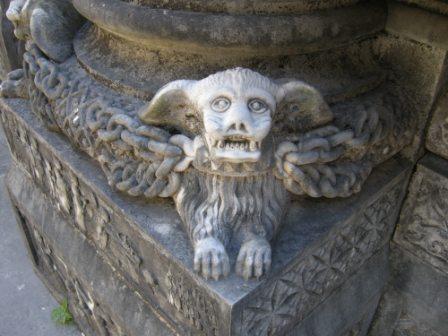 A friendly gargoyle.
A friendly gargoyle.
Poor Julia had to drive into the city of Lisbon. She did a great job, as usual.
But the GPS (NAV Chica) failed us once again and did not find the exact location
of our hotel. So Julia circled the car around the hazard-filled streets and
eventually found it. But because of the crazy roads and unintelligible signs,
Julia ended up parked in front of the hotel in the wrong direction. I left to
check us in, and while I was away, Julia was accosted by two hostile hotel staff.
Each barked at Julia to move the car. In the end, she lost her cool and told them
in no uncertain terms to pull their heads in (well, something like that). Once
they realized we were checked in, they changed their attitudes and could not have been
more helpful and polite to poor Julia.
Lisbon is a typical modern big city, and I do not like typical modern big
cities. So our short walk to the old section of town really did not do much for
me. It's not that Lisbon is any worse than any other big city. It's just that it
is pretty much the same as all big cities: dirty, smoky, grimy, dusty, and full
of hustle and bustle. We walked to the waterfront and then on to the Sé de
Lisbona (the Lisbon Cathedral). These sites did not change my opinion much. But
Lisbon did not change my opinion of Portugal in general. The food is good here,
and the people are friendly.
Goodbye, Portugal.
Goodbye Portugal Video
Trip Stats
Miles Flown: 22,236
Miles Hiked: 262
Miles Skied: 2
Miles Driven: 5,666
Miles Sailed: 110